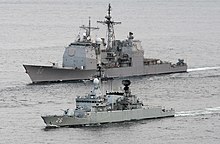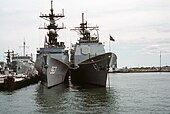Ticonderoga-class cruiser
However, the increased combat capability offered by the Aegis Combat System and the passive phased array AN/SPY-1 radar, together with the capability of operating as a flagship, were used to justify the change of the classification from DDG (guided-missile destroyer) to CG (guided-missile cruiser) shortly before the keels were laid down for Ticonderoga and Yorktown.
Due to the high cost of maintenance and age, the entire class is being progressively retired; the last vessels are scheduled for decommissioning in 2027.
They were to complement the much larger and more capable Strike Cruiser (CSGN) comprising the high end, which were expected to act as flagships.
Four Ticonderoga-class cruisers, plus 21 Arleigh Burke-class destroyers, were scheduled to be equipped for anti-ballistic missile and anti-satellite operations.
[9] In March 2019, the Navy proposed decommissioning the six oldest ships, Bunker Hill, Mobile Bay, Antietam, Leyte Gulf, San Jacinto, and Lake Champlain, in 2021 and 2022, instead of dry-docking them for life-extension maintenance updates as a cost-saving measure.
[11] In December 2020, the U.S. Navy's Report to Congress on the Annual Long-Range Plan for Construction of Naval Vessels stated that the following ships were planned to be placed Out of Commission in Reserve:[12] At this time, the proposed dates were: In July 2021, the Navy requested to retire seven cruisers in the Fiscal Year 2022, adding Lake Champlain (CG-57) to the six listed above.
In November 2024, the Department of the Navy announced that the Gettysburg, Chosin, and Cape St. George would have their service life extended through 2029, following extensive upgrades as part of a modernization program.
Flight III Arleigh Burke-class destroyers equipped with the Air and Missile Defense Radar provide enhanced coverage, but putting the radar on standard destroyer hulls does not allow enough room for extra staff and command and control facilities for the air warfare commander.
Destroyers can be used tactically for air defense, but they augment cruisers that provide command and control in a carrier group and are primarily used for other missions like defending other fleet units and keeping sea lanes open.
Congress opposed the plan on the grounds that it makes it easier for Navy officials to completely retire the ships once out of service.
[19] Due to the large overlap in size and capabilities of its guided missile cruisers and destroyers, the Navy eventually coalesced them into a single class of large multi-mission ships with an emphasis on air and missile defense called Large Surface Combatants (LSC); in 2018, the Navy stated that a future LSC would have capabilities of the Flight III Arleigh Burke-class guided-missile destroyers as a starting baseline while having future growth margins and air defense command and control of the Ticonderoga class.
Some cruisers reported some structural problems in early service after extended periods in extremely heavy seas; they were generally corrected from the late 1980s to the mid-1990s.
The later Arleigh Burke-class Aegis destroyers are designed from the keel up to carry the SPY-1D radars and have them all clustered together on the forward deckhouse, saving space and weight and simplifying cooling requirements.
In addition to the added radar capability, the Ticonderoga-class ships built after USS Thomas S. Gates (CG-51) included two Mark 41 Vertical Launching Systems (VLS).
After the end of the Cold War, the less capable original five warships were limited to duties close to the home waters of the United States.
[24] In October 2024, the US Navy reported the successful testing of a prototype Transferrable Reload At-sea Method for replenishment.
The most recent upgrade packages include SM-6 and Naval Integrated Fire Control – Counter Air (NIFC-CA) capability.
[27][28] USS Vincennes (CG-49) achieved notoriety in 1988 when, amid a running gun battle with Iranian Revolutionary Guard gunboats, she shot down Iran Air Flight 655, resulting in 290 civilian deaths.
[29][30] The commanding officer of USS Vincennes, William C. Rogers III, believed the airliner to be an Iranian Air Force F-14 Tomcat fighter jet on an attack vector, based on misreported radar returns.
[31] On 14 February 2008, the United States Department of Defense announced that USS Lake Erie (CG-70) would attempt to hit the dead satellite USA-193 over the North Pacific Ocean just before it would burn up on reentry.




